
PUMPA - SMART LEARNING
எங்கள் ஆசிரியர்களுடன் 1-ஆன்-1 ஆலோசனை நேரத்தைப் பெறுங்கள். டாப்பர் ஆவதற்கு நாங்கள் பயிற்சி அளிப்போம்
Book Free DemoDiffusion is the movement of molecules (gases, liquid or solids) from a region of higher concentration to a region of lower concentration down the concentration gradient.
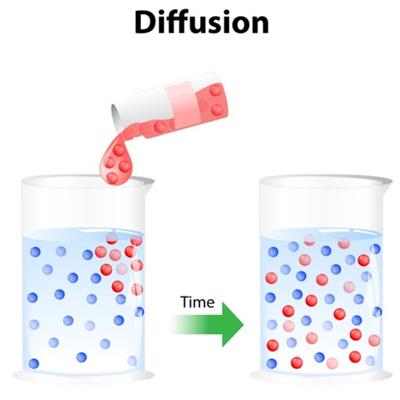
Process of diffusion
Gas exchange during respiration occurs through diffusion. During inspiration, air containing oxygen crosses the lung alveoli through diffusion. Then, it enters the blood and travels to various organs as well as tissues. Here oxygen is exchanged for carbon dioxide.
The carbon dioxide exits the capillary of the blood, enters the blood and travels back to the lungs. This is expired out of the body during expiration.
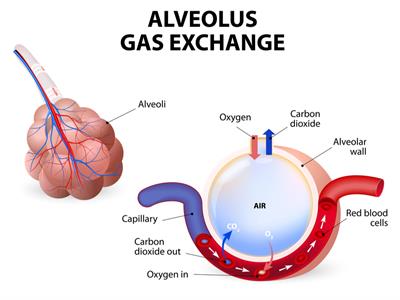
Exchange of O_2 and CO_2 in the alveolus and blood capillary
How are alveoli designed to maximize the exchange of gases?
The lung alveoli are thin-walled and supplied richly with blood capillaries, facilitating the exchange of gases between the blood and the alveoli. The alveoli also have a balloon-like structure with thin walls, which provides greater surface area for the exchange of gases.
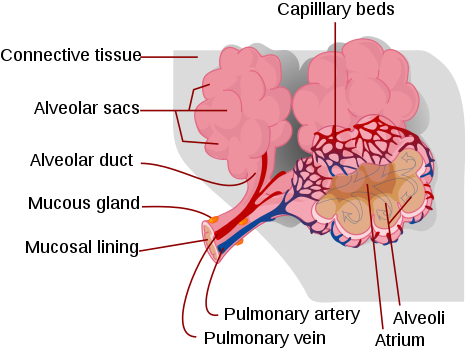
Alveoli
Gaseous exchange in humans
When the size of the animals is large, diffusion alone is not sufficient to deliver oxygen to all the parts of the body. Respiratory pigments like haemoglobin (Hb) present in the red blood corpuscles (RBC) takes the oxygen from the air in the lungs and carries it to oxygen-deficient areas.
Oxygen is carried by haemoglobin as it has a high affinity for oxygen. Each of the haemoglobin binds to four molecules of oxygen. The blood carries the oxygen bound haemoglobin to various tissues. Since CO_2 is more soluble in water than O_2, they are transported in the dissolved form in the blood.
Did You Know that the levels of haemoglobin vary?
The haemoglobin levels in male, female and in children varies from person to person. The normal haemoglobin levels is depicted below:
|
Category
|
Haemoglobin levels in g/dl
|
| Male | 13.5 - 17.5 |
| Female | 12.0 - 15.5 |
|
Children (age 2- 6 years)
|
11.5 - 13.5 |
| Children (age 6- 12 years) | 11.5 - 15.5 |
The haemoglobin values in a male and female child do not differ significantly. However, there is a difference in haemoglobin values after the puberty. The testosterone release during male puberty influences erythropoiesis. Thus, there is higher haemoglobin in males. Also, in females, menstruation, childbirth, and breastfeeding tend to lower the haemoglobin levels.
There are differences in male and female haemoglobin levels in animals such as cattle and buffalos too. The haemoglobin level in a cow 10 - 12 g/100 cc and in a bull it is 12 - 13 g/100 cc. While the calves have an average haemoglobin level of 8.96 g/100 cc.
Important!
If diffusion is the only gaseous exchange mechanism in human, a molecule of oxygen would take 3 years to reach the toes from the lungs.!
Smoking
Smoking is injurious to health. Smoking is a highly damaging and destructive behaviour that damages the lungs.
Smoking causes lung cancer, which is one of the common causes of death worldwide. As we have already seen, cilia are tiny hair-like structures that line the upper respiratory tract, including the nose, trachea, as well in bronchus.
The cilia assist in the removing microorganisms, dust and other harmful particles present in the inhaled air. Smoking destroys the cilia that cause the microorganisms, dust, smoke and other hazardous chemicals to enter the lungs, causing infection, cough and potentially lung cancer.
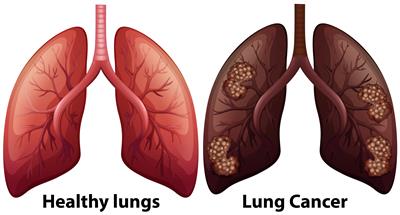
Healthy lungs vs Cancer lung
Smoking not only causes lung cancer but also causes other types of cancer.

When you smoke, the cigarette fumes make the thin alveolar wall rupture. The surface area available for gaseous exchange reduces. As a result, the heart needs to pump more blood to compensate for reduced gaseous exchange. Heart failure can result from this overburdening of the heart.
The use of tobacco directly or in any form that includes cigarettes, cigar, bidis, hookah, gutkha etc., affects not only the lungs. The tongue, heart and liver are also affected by tobacco use!
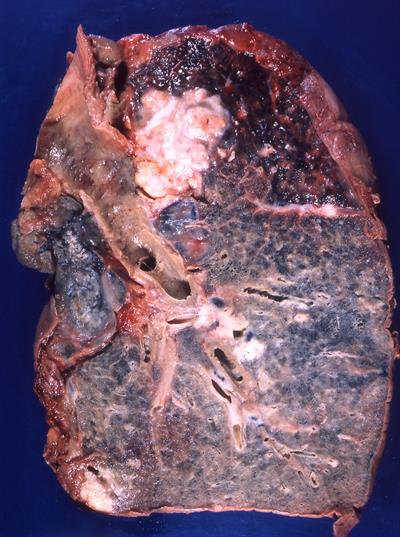
Lung affected due to use of tobacco
Heart attack, strokes, pulmonary diseases, and various malignancies are linked to the use of smokeless tobacco. The chewing of tobacco in the gutkha causes a high prevalence of oral cancer in India. Say NO to tobacco and its products to stay healthy!
Reference:
https://www.flickr.com/photos/pulmonary_pathology/3922611335
https://commons.wikimedia.org/wiki/File:Tobacco_cancers_caused.svg
https://www.vecteezy.com/vector-art/302186-human-anatomy-of-lung-condition